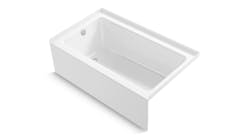Latest from Trucks
Sponsored
Most plumbing companies need to track a fleet of vehicles throughout the day to keep track of employee performance and gauge worker availability.
When spread out across a business’s service area, these vehicles can be hard to track—making it difficult to estimate worker productivity and meet customer needs.
The right tools can help plumbing companies maintain accountability of their fleet—tracking them as they move from job to job, providing deep insights into productivity and daily operations.
1. Start With a Tracking Solution
If your business doesn’t use one already, a comprehensive fleet management solution is essential. These tools enable you and your team to track company vehicles, drivers and assets as they move from job to job.
Without some kind of fleet tracking tool in place, you won’t be able to follow your team as they work, reducing your ability to communicate with them and to coordinate workers.
Once you have a GPS solution or similar location-tracking tool providing information, you can extend your tracking solution with vehicle telematics. The right sensors and monitors will allow you to track assets, like saw kits or drain cleaning machines, in addition to vehicles.
The right sensors can also enable the tracking of vehicle and asset health, offering a real-time view into the operational performance of each of your vehicles. These sensors will help you to know if vehicles need maintenance and when you should next bring them into a maintenance shop.
Even simple technology, like an odometer that reports vehicle mileage to your fleet tracking tool, can enable a system to send automated service alerts based on vehicle maintenance schedules.
These tools can help you stay on top of vehicle and asset maintenance, allowing you to minimize downtime and reduce maintenance costs in the long run.
It’s important that once you choose a system, you keep it updated — and replace it when necessary. Modern equipment and IT systems are the easiest to maintain. Legacy systems may not be compatible with modern sensors, and in some cases may not be supported at all.
2. Train Drivers and Track Local Regulations
Effective fleet management also requires careful management of your drivers.
Ideally, your team will be able to drive responsibly and efficiently. They’ll also be able to communicate effectively with each other, coordinating operations and ensuring that all work is properly documented—invoices signed and necessary paperwork filled out.
Some fleet management platforms also serve as driver management platforms. They provide communication tools that can help keep drivers in touch and prevent communication breakdowns—like missed calls and “phone tag.”
Effective training is essential for any industry, especially industries like construction and plumbing, and is necessary for your employees to perform well in the field.
The right training, however, should go beyond just training your employees in plumbing and customer service.
Driver training can also help to reduce maintenance costs and fleet fuel consumption. Idling, for example, can significantly decrease vehicle fuel efficiency—to the point that many large companies have limits on how long their drivers can leave a vehicle idling for. If you can prevent drivers from idling frequently, you may be able to save on gas.
Stopping and starting also tends to consume a large amount of fuel—similarly training drivers to avoid unnecessary braking can help to both save fuel and reduce wear on vehicle brakes.
So long as these training programs are mandatory and company-wide, they can help you to significantly reduce fuel consumption and vehicle wear and tear.
When determining what training your employees need, you may also want to review local laws and regulations around commercial vehicles.
Many cities are adopting anti-idling legislation, for example, which penalizes businesses who allow drivers to leave vehicles idling for certain lengths of time. Idling can be managed with the right training and fleet management software, helping you to avoid potential fines and penalties.
3. Regular Service and Roadside Assistance
Standard vehicle maintenance can be expensive — even simple, recommended maintenance procedures like oil changes, tire rotations and spark plug replacements can appear to significantly increase the cost of ownership of your vehicle fleet.
Regular maintenance and servicing, however, is one of the best ways to keep long-term fleet management costs as low as possible. Routine service will help to prevent problems that can arise from normal vehicle use. Service can also help you to catch any more serious problems that may be developing, potentially helping you to repair or replace parts before they cause a breakdown—and serious downtime as a result.
Maintenance can also help to improve fuel efficiency and reduce operating costs. A vehicle with properly inflated tires, for example, will consume less fuel than one with under-inflated tires.
Roadside assistance is another recurring cost, but it can provide similar benefits. When a car breaks down or won’t start, your team will have someone to call who can provide immediate assistance—whether they need a jump or a tow.
Having a roadside assistance plan can both reduce costs and provide some additional protection to employees when a vehicle breaks down.
4. Know What to Outsource
Not all fleet management operations have to happen in-house. Many plumbing companies choose to outsource certain aspects of fleet management, like maintenance and fleet services.
Smaller plumbing companies typically can’t handle the cost of hiring additional maintenance staff and outfitting an additional facility with fleet maintenance tools.
Larger companies may be able to manage these costs, but may also find that the benefits of operating an in-house maintenance shop aren’t worth the associated expenses.
Both may benefit from maintaining in-house services, but it’s typically simpler and cheaper in the long-run to outsource some or all maintenance and fleet services.
Many businesses will also outsource fleet services if they lease their vehicles from a third party. These vehicle lenders typically offer fleet services with the lease, and in some cases they will take on the cost of routine maintenance as part of the deal.
Keeping Track of a Plumbing Vehicle Fleet
Tracking your company’s vehicles and assets throughout the day can be difficult—especially if you don’t have the right tracking software and tools.
Simple upgrades and process adjustments—like a fleet management solution, driver training and routine vehicle service—can help you to maintain accountability of your vehicle fleet.
In many cases, it’s also possible to outsource many fleet vehicle services. Smaller companies especially will benefit from finding a business partner that can handle maintenance and routine service.
Rose Morrison is a freelance writer who covers construction, home improvement, and contracting topics. She is also the managing editor of Renovated.com, a site dedicated to the latest trends in the home industry. She has a passion for innovative technologies that are making the home industry sustainable and efficient. Check out Renovated.com to see more of her work.

Rose Morrison
Rose Morrison is a freelance writer who covers construction, home improvement, and contracting topics. She is also the managing editor of Renovated.com, a site dedicated to the latest trends in the home industry. She has a passion for innovative technologies that are making the home industry sustainable and efficient. Check out Renovated.com to see more of her work.


